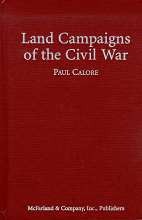
CALORE : Land campaigns of the Civil War (előszó)
The American Civil War is perhaps the most significant single event ever experienced by the people of this country. In terms of its human misery, physical destruction, and the loss of life and property, the war resulted in enormous suffering.
The causes of the war were rooted in a divided political and social ideology of a young and troubled nation. The loss of more than a half million American lives over four terrible years was presumed to have settled those divisive issues, but even during the Reconstruction years that followed, it was necessary to continue addressing the civil rights and racial equality disputes that contributed so significantly to the onset of the war. In an attempt to clear up the disillusionment following emancipation, additional federal action was necessary, including constitutional amendments, the Freedmen's Bureau, and various civil rights laws.
The Civil War has been over since 1865, yet there is still a residue of those same problems confronting our nation today. Traceable to those chaotic years, civil rights issues are still being fought over, albeit in the more subtle battlefields of the American courtroom, state governments, and the U.S. Congress.
In that sense, the Civil War is a continuing conflict, and the struggle to relieve these remaining social tensions goes on. There is a clear connection between our present-day racial problems and the racial problems of the Civil War years. This connection is one of the subliminal motivations that drives the student of American history on his or her search for additional knowledge of this period. The reader seeks an understanding of those times, both to become better informed about the history of today's sensitive social ills and to understand the mechanics of the conflict. The Civil War materials on the shelves of today's bookstores are "specialty books" on specific topics or personalities associated with the conflict. There are books on a great number of particular battles, both large and small. One is also never at a loss to find books dealing exclusively with any number of Civil War generals, both Union and Confederate. Likewise on the shelves are Civil War source books, battlefield guides, photographic histories, question-and-answer books, the memoirs of soldiers, books on memorabilia, spies, accounts of heroes, and works on many other Civil War topics.
There is no question that the reading public benefits tremendously from this proliferation and diversity of subject matter. No matter what level of expertise or interest the Civil War reader has, there is almost always a book to fill his or her need.
However, for the person looking for a first volume on the Civil War, the above books may not serve adequately. A first-time researcher looking for a book on the history of the Civil War itself will discover that the books available seem to be written mostly for the more advanced reader. Learned and respected historians write the majority of these books. Their styles commingle United States political history, in-depth social commentary, and everything else connected to that period with the fighting of the war. For a comprehensive understanding of those turbulent years, this kind of analysis is necessary. But not everyone is looking for a deep analytical study of those times. Without a basic understanding of Civil War events, the reader may not be able to fully enjoy the benefits of these in-depth works, no matter how well they are written. I suspect that many readers may become confused after reading page after page of sometimes tedious detail. Such encounters may result in a loss of interest.
It is my opinion that a definite need exists for a Civil War history that is simplified, understandable and easily readable. I think this book will fill that need. Simply written, Land Campaigns of the Civil War is an ideal book for students, teachers, Civil War aficionados, and partisans of American history. It is succinct but complete, accurate and to the point.
In writing this book, I endeavored to accomplish several goals. The first was to provide a brief background of the political events that set the stage for war, the events that many historians believe had a significant contribution to the outbreak of hostilities. And, second, I wanted to present a complete account of the Civil War land campaigns that could be easily understood without relying on an abundance of extraneous detail and commentary.
My challenge was to describe the events of those four terrible years in a compressed and simplified format without compromising the facts. Despite the fact that the war was fought on three different fronts, sometimes at the same time, I tried to offer the reader a seamless flow of events in order to provide a better grasp of the war's chronology. Understanding the sequence of events is fundamental for the reader to capture the whole picture. I hoped to reduce the complexity in this area, and to clarify the relationships among the various armies.
This book is for those wanting a baseline or foundation of Civil War knowledge. I hope that by providing this foundation, I have also provided an impetus for further study. With this book in the reader's "tool kit," an understanding of specialized and highly detailed works on the Civil War will certainly be easier—and as a consequence, a much more enjoyable reading experience.